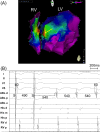Acute failure of catheter ablation for ventricular tachycardia due to structural heart disease: causes and significance
- PMID: 23727700
- PMCID: PMC3698765
- DOI: 10.1161/JAHA.113.000072
Acute failure of catheter ablation for ventricular tachycardia due to structural heart disease: causes and significance
Abstract
Background: Acute end points of catheter ablation for ventricular tachycardia (VT) remain incompletely defined. The aim of this study is to identify causes for failure in patients with structural heart disease and to assess the relation of this acute outcome to longer-term management and outcomes.
Methods and results: From 2002 to 2010, 518 consecutive patients (84% male, 62 ± 14 years) with structural heart disease underwent a first ablation procedure for sustained VT at our institution. Acute ablation failure was defined as persistent inducibility of a clinical VT. Acute ablation failure was seen in 52 (10%) patients. Causes for failure were: intramural free wall VT in 13 (25%), deep septal VT in 9 (17%), decision not to ablate due to proximity to the bundle of His, left phrenic nerve, or a coronary artery in 3 (6%), and endocardial ablation failure with inability or decision not to attempt to access the epicardium in 27 (52%) patients. In multivariable analysis, ablation failure was an independent predictor of mortality (hazard ratio 2.010, 95% CI 1.147 to 3.239, P=0.004) and VT recurrence (hazard ratio 2.385, 95% CI 1.642 to 3.466, P<0.001).
Conclusions: With endocardial or epicardial ablation, or both, acute ablation failure was seen in 10% of patients, largely due to anatomic factors. Persistence of a clinical VT is associated with recurrence and comparatively higher mortality.
Keywords: catheter ablation; failure; outcome; structural heart disease; ventricular tachycardia.
Figures







References
-
- Poole JE, Johnson GW, Hellkamp AS, Anderson J, Callans DJ, Raitt MH, Reddy RK, Marchlinski FE, Yee R, Guarnieri T, Talajic M, Wilber DJ, Fishbein DP, Packer DL, Mark DB, Lee KL, Bardy GH. Prognostic importance of defibrillator shocks in patients with heart failure. N Engl J Med. 2008; 359:1009-1017 - PMC - PubMed
-
- Stevenson WG, Wilber DJ, Natale A, Jackman WM, Marchlinski FE, Talbert T, Gonzalez MD, Worley SJ, Daoud EG, Hwang C, Schuger C, Bump TE, Jazayeri M, Tomassoni GF, Kopelman HA, Soejima K, Nakagawa HMulticenter Thermocool VT Ablation Trial Investigators Irrigated radiofrequency catheter ablation guided by electroanatomic mapping for recurrent ventricular tachycardia after myocardial infarction: the Multicenter Thermocool Ventricular Tachycardia Ablation Trial. Circulation. 2008; 118:2773-2782 - PubMed
-
- Aliot EM, Stevenson WG, Almendral‐Garrote JM, Bogun F, Calkins CH, Delacretaz E, Della Bella P, Hindricks G, Jaïs P, Josephson ME, Kautzner J, Kay GN, Kuck KH, Lerman BB, Marchlinski F, Reddy V, Schalij MJ, Schilling R, Soejima K, Wilber D. EHRA/HRS expert consensus on catheter ablation of ventricular arrhythmias. Heart Rhythm. 2009; 6:886-933 - PubMed
-
- Carbucicchio C, Santamaria M, Trevisi N, Maccabelli G, Giraldi F, Fassini G, Riva S, Moltrasio M, Cireddu M, Veglia F, Della Bella P. Catheter ablation for the treatment of electrical storm in patients with implantable cardioverter‐defibrillators: short‐ and long‐term outcomes in a prospective single‐center study. Circulation. 2008; 117:462-469 - PubMed
Publication types
MeSH terms
Grants and funding
LinkOut - more resources
Full Text Sources
Other Literature Sources
Medical

